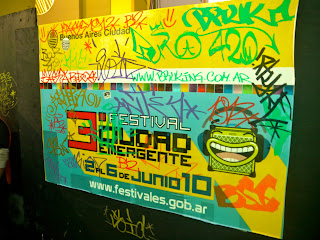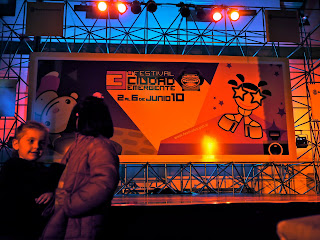
We in here! Taggers left their mark on all of the Festival Signs
While just two years ago, it seemed that most Porteños only recognized the word hip-hop as a weird new style on the show So You Think You Can Dance, lately the culture is gaining some visibility on the mainstream stage.
June 2-6 more than 130 thousand people attended the third annual La Festival Cuidad Emergente in Buenos Aires! This government funded festival an outlet for emerging yet often neglected alternative youth cultures. True it's name, "The Festival of the Emerging City" lends a legitimating stage to up and coming musicians, dancers, artists, and fashion designers who capture urban youth movements and sensibilities. The past 2 years were dominated by indie rock bands and electronica djs, but in 2010 a new flavor is moving in on the spotlight.
Hip-hop definitely had the crowd saying "haay!" or at the very least "hmmm" every day of the festival. Each of the elements of hip-hop were well-represented with showcases of two different live hip-hop bands, four groups of bboys, numerous turntabilist, and an entire 30 foot wall of the Recoleta Cultural Center transformed by a team of graffiti artists. The young hip-hop heads came in crews often rocking their hoodies and addidas snap-ups as silent unifiers. Meanwhile, large crowds of families, often without prior exposure to hip-hop, would stop dead in their tracks, mouth agape to capture the phenomenon.

The Graff crew posing in front of their work

The festival goers were witnessing one of the first times that Buenos Aires hip-hop culture had peeked its head up above the waves of the underground. Due to a dominating culture of rock, cumbia, and electronica, Buenos Aires is not yet an epicenter of hip-hop like it's neighboring capital cities. Montevideo is much more accepting of any music that comes from the "Afro" tradition, and Santiago undoubtedly has one of the biggest hip-hop scenes in America Latina. These norms look to be changing in Buenos Aires as local hip-hop artists continue to unify more comfortable local sounds with the new and the disparate. The fan base is growing as young music aficionados cross the borders from popular genres such as reggaeton, electronica, and cumbia villera, into the land of hip-hop
The most popular hip-hop performers in Buenos Aires (and much of Latin America) have found impressive ways to localize the globally imported concept that is hip-hop culture, by transforming it with local flavors, and reclaiming it as their own. Groups such as Columbia's Bomba Estereo pay homage to their local music traditions by rhyming over psychedelic cumbia samples, and spitting out clave rhythms with ease. Uruguay's Contra de Las Cuerdas have been successful rapping over their own local popular forms of music like Tango and Candombe, (the traditional Afro-Argentine/Uruguayan form of drum and dance).
The band of five, Marcelo (mc), Cesar Gamboa "Sapo" (Dj) Gerardo (teclados, acordeon etc) Eduardo (bajo,guitarras) and Ferna (Percusiones) played on June 4th to a crowd of around 300 people. Their hardcore fans sung along with the words, often rich with political rhetoric, while the rest of the crowd was hooked in by the group's diverse grooves. Some moved their hips with the latin groove of their Candombe tambores, others bobbed their heads to their melodious rock guitar riffs, while others still swayed nostalgically to the dramatic tango accordion. What's not to like?
As the keyboardist grabbed an accordion, and the mc grabbed a guitar, I understood why they had been jamming all around Latin America together for the last eight years. Each of the members of Contra Las Cuerdas is a true musician who plays to constantly stretch musical boundaries. Uninterested in attempting to conform along boundaries of genre or image, Contra Las Cuerdas basist Eduardo describes their form of hip-hop as their " way to be honest, a way to not go around copying what's already out."
Perhaps just as important as their musicianship was their consciousness of the importance and possibilities of hip-hop culture as it grows in Latin America and in the rest of the world.
"We know that there were hundreds of people in the audience who had never seen us before. And by the end, you could see, they were dancing. Hip-hop isn't just a music, it's a language. It's a language that gives every pueblo in the world an opportunity to speak. It's truly an intersections of urban productions. I grew up with my dad listening to tango, but for someone else it might have been Brazilian music, or a murga. We come from various intersections and with hip-hop we all come together." continued Eduardo
Andrea Senera, the curadora del Festival de Danza Contemporánea corroborates this sentiment as she talked about the dance portion of the festival named "danza callajera" or street dances. This year featured three purely bboy crews and four more dance troupes who incorporated hip-hop in their dance routines. "La idea es mezclar lenguajes," she said in reference to her desire to display both dancers who had been "formally" trained in dance schools with those who have been trained on the street and "viven su arte".
I caught The Fuera de Limite Crew and was definitely impressed by their acrobatic skills, old school poppin, and one of the dopest b-girls that I've seen in a long time. The patio was filled to the brim with teenagers, yes, but also families, little young ones all privy to the visual development of this form of expression.
B-girl GET IT!
Fuera de Limite Crew gettin it in.
Even the fashion design portion was called the Fashion show "Dancehall Dmode" and was emceed by a local rapper Ms. Boliva.
And here emerges the next generation of hip-hoppers: B-babies watching the show
Though many of the hip-hop events didn't attract as many people as the headlining rock bands, the crowds were still robust and energetic. There is not much mainstream attention for hip-hop in Buenos Aires, yet the many youth that participate sure as hell aren't sitting around waiting to make the news. They've continued to live the culture of hip-hop despite it's current lack of lucrative outlets, lack of available spaces, and disinterest from the mainstream. Behind these peripheral cultures, you'll often find the marginalized youth that also live in the peripheries of society. Those who don't have a voice on a formal stage, those who don't have the opportunity to take dance lessons at a "formal" institution, and those who aren't handed these alternative spaces of expression--they have to work to build their own. Hip-hop culture has captured the hearts of many of these youth, and for this reason it was truly the cornerstone of this years Festival Cuidad Emergente.
Director of the festival Viviana Carter spoke a bit about these marginalized cultures in particular,
"This Festival is a space for us to begin to create. Many from this generation had to learn how to take care of themselves and they are just looking for spaces to express themselves." As more of these legitimate spaces and opportunities are presented for these youth to take on their own identities, the more they will feel justified in spending their time in energy in dance and hip-hop. "I think it's healthy that they are putting this much intense energy into dance and constructive things instead of stealing, robbing, and taking paco, [a very popular street drug similar to crack,]" says Silvina Szperling, another dance curator for the festival.
One thing is for sure, the hip-hop community may be just emerging but is poised for an explosion. As Andrea Servera, the festivals curator of dance confirms, "levantás un adoquín y sale un bboy. Eso es algo que no pasa con otras danzas." (You turn over a rock, and out comes a bboy. This is something that isn't happening with other forms of dance).
And judging by the incredible amounts of taggers who left their mark on just about every Cuidad Emergente sign in the festival, the heads are letting people know that, "We're in here, you'll notice us, and we're not goin anywhere."

No comments:
Post a Comment